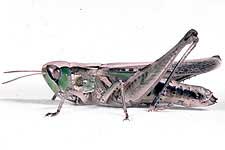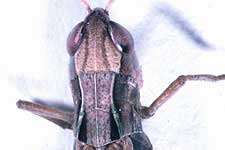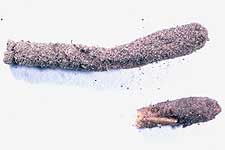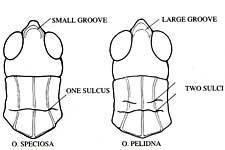|
Slantfaced
Pasture Grasshopper Wyoming Agricultural Experiment Station Bulletin 912
Distribution
and Habitat Click here for the printable version
The slantfaced pasture grasshopper ranges widely in North American grasslands from east of the Rocky Mountains to the Atlantic Coast and from southern Canada to northern Mexico. The species is most abundant in upland areas of short grasses in the tallgrass and southern mixedgrass prairies. In the shortgrass prairie of Colorado and New Mexico, it inhabits mesic swales. Generally preferring mesic habitats, its center of distribution appears to be in the tallgrass prairie where its populations often become numerically dominant. In eastern states this grasshopper occurs principally in relatively dry upland and hilly pastures with sandy loam soil and often becomes abundant and the dominant species. The slantfaced pasture grasshopper is a common, often numerically dominant, species in the tallgrass prairie region. Populations fluctuate in density increasing during a series of dry years along with other grassland species. Because it feeds almost exclusively on grasses, it contributes to the overall damage of forage by an assemblage of grass-feeding grasshoppers. In western Iowa during the outbreak of 1934 to 1937, it, in concert with Ageneotettix deorum and a few less numerous species, destroyed all green vegetation in bluegrass pastures. Assemblages ranged from 30 to more than 100 per square yard. Because the slantfaced pasture grasshopper is a small species, about half the size (weight) of A. deorum, it presumably eats less and causes less damage to forage. Live weight of adult males collected in Comanche County, Kansas, 29 August 1997, averaged 86 mg and adult females 173 mg (average dry weight of males 28 mg, and of females 58 mg). The slantfaced pasture grasshopper is a general grass feeder, exhibiting some preferences among species of grasses. It usually feeds on grasses in proportion to their availability. Examination of crop contents of grasshoppers collected in the tallgrass prairie of eastern Kansas revealed that the common plants ingested were blue grama, sideoats grama, Kentucky bluegrass, little bluestem, and big bluestem. Because this grasshopper prefers to inhabit areas of short grasses, mowed fields, and heavily grazed pastures, a large proportion of crops, 16 to 27 percent, contained blue grama and Kentucky bluegrass. Fragments of other grasses detected in crops included buffalograss, hairy grama, prairie junegrass, western wheatgrass, tall dropseed, sand dropseed, Leibig panic, Scribner panic, switchgrass panic, prairie sandreed, reed canarygrass, prairie threeawn, stinkgrass, and yellow bristlegrass. Fragments of three species of sedges were also found: Penn sedge, needleleaf sedge, and fieldclustered sedge. Unidentified fungi were present in 6 percent of the crops of grasshoppers from Kansas and 8 percent from North Dakota. A few crops contained forbs and arthropod parts. Because of this grasshopper's wide distribution, it no doubt feeds on many other species of grass. In Michigan it has been observed to feed on Canada bluegrass (Poa compressa), arrowfeather threeawn (Aristida purpurascens), and poverty oatgrass (Danthonia spicata). In a small patch of short grass within the tallgrass prairie of Comanche County, Kansas, two observations were made of method of feeding. On 24 August 1997 at 10:30 a.m. DST (temperature 1 inch above the ground was 79°), a pair in copulo hopped onto the top of blue grama and landed horizontally. After five minutes of basking, the female cut through a leaf, held onto the detached portion, and began to feed on the cut end. She fed briefly, crawled a short distance on top of the grass, and began to bask again. A second female was discovered resting horizontally on the top of a blue grama plant, stirred and oriented itself diagonally, and then began to feed on the tip of a leaf. Because of the scant number of observations of feeding in nature, several observations were made in a terrarium stocked with turf of blue grama, western wheatgrass, and bare soil. Adults jumped or climbed onto the blue grama and fed vertically, head-up on the edge of a leaf, and moved up the leaf ingesting about 1/8 inch of leaf edge at a time. Thin edges of the attacked leaves were left standing. In another cage a female jumped onto the base of an 8-inch green leaf of downy brome and began to feed from a vertical head-up position on the edge of the leaf. Eating upward on the leaf, the grasshopper continued feeding for 18 minutes and then ceased. During this time the female consumed green leaf tissue 2 3/8 inches long by 1/8 inch deep and caused a gouge in the leaf of these same dimensions. A residual edge of 1/8 inch width was left standing. Occasionally a leaf was cut through; the grasshopper held onto the detached section with the front tarsi, eating the green material completely and dropping the yellow, dry tip. Adults were also observed to feed head-down on leaf edges. The slantfaced pasture grasshopper possesses long wings that allow it to disperse widely. In Lincoln, Nebraska one male and seven females were captured at night at electric lights 1 July 1921 indicating that these adults dispersed from surrounding tallgrass prairie. As valuable as such collections are in providing evidence of dispersal and migration, they leave several pertinent questions unanswered, especially grasshopper densities and meteorological data of the beginning, duration, and ending of flight. Of considerable significance is the swarming of populations in the New England states. Flushed flight is silent, often straight, but sometimes circular, for distances of 1 to 4 feet and usually at heights of 4 to 12 inches. Flushed flight, however, may be as high as 5 feet (1 of 16 observations). Flights were chiefly crosswind but one was into a variable wind that ranged from 3 to 10 mph.
The slantfaced pasture grasshopper is a small, long-winged species with a variety of color patterns of brown, tan, and green (Fig. 6 and 7). Specimens are usually spotted and marked with brown and black. Some individuals bear much green while others are entirely tan and brown. The face is strongly slanted. The antennae are filiform. Compound eyes are tan with fuscous spots and markings. Behind each eye on the side of the head is a broad fuscous band, above it a thin black line, and above the latter a light line often colored ivory. A second species, Orphulella pelidna, inhabits the prairies east of the Rocky Mountains in greater abundance than O. speciosa. The two species can be distinguished from one another by structural differences. The slantfaced pasture grasshopper, O. speciosa, has a small semicircular depression of the vertex that is closer to the front and the lateral carinae of the pronotum incised once (Fig. 8 and Fig. 10). O. pelidna, a larger species, has a larger semicircular depression set farther back and the lateral carinae incised twice, occasionally three times (Fig. 10). The nymphs are identifiable by their shape, structures, and color patterns (Fig. 1-5). 1 . Head. Compound eyes tan and spotted brown; face strongly slanted; antennae of instar I terminally expanded, antennae of instar II flat and terminally pointed, antennae of instars III to V filiform; semicircular depression of vertex located close to front of fastigium; head of instars I and II with patterns of green, of instars III to V with patterns of tan, brown, green, and fuscous. 2. Lateral carinae of pronotum incised once, colored ivory, sometimes green on metazona in older instars; hind femur with medial and upper marginal areas of instars I and II tan, of instars III to V fuscous; lower part of medial area and lower marginal area pale gray. Thorax of instars I and II with patterns of green, of instars III to V patterns of tan, brown, green, and fuscous. 3. Abdomen in instars I and II green with darker green band on each side that runs forward on lateral lobe and side of head to eye, in instars III to V the lateral band is fuscous. The slantfaced pasture grasshopper is a late-developing species hatching about the same time as Phoetaliotes nebrascensis, a common coinhabitant of the tallgrass prairie. In the Flint Hills, Kansas (elevation 1,200 ft), hatching of the slantfaced pasture grasshopper began 16 May 1957-59 and 22 May 1976-78. The hatching continued for four to six weeks. In Comanche County, southcentral Kansas (elevation 2,000 ft), hatching began 10 June 1993. In northcentral Colorado (elevation 5,750 ft), hatching began in mid June 1958-60 and in eastem Montana (elevation 2,000-3,000 ft), 25 June 1950-51. In the Flint Hills in 1976-78 the period of hatching ranged from 20 days in the south to 47 days in the north. In the north some eggs were still hatching when some instar-V nymphs were nearly ready to become adults. Nymphs of the slantfaced grasshopper develop through five instars to reach the adult stage. Several studies of the life history conducted in the Flint Hills of Kansas indicate a nymphal period of 42 to 48 days, as determined from date of first hatch to first adults. Adults usually remain in favorable habitats of short grasses where they have developed as nymphs. Here they mature, mate, and reproduce, persisting generation after generation, frequently fluctuating in density. In the Flint Hills of Kansas adults first appeared 2 July 1957-59 and 5-9 July 1976-78 and in Comanche County, Kansas 17 July 1997. Near Boulder, Colorado adults first appeared by mid July 1958-60 and in eastern Montana by 5 August 1950-51. The peak of abundance of adults in the Flint Hills occurred in August. Courtship of females by males was observed on the George Reserve, Michigan and in Southwestern Quebec. Males may court females by stridulating, making a faint ticking sound, repeated three to ten times. Males stalk moving females slowly and stealthily and when close enough, pounce on them without signaling. After the pair coupled, any disturbance or stirring of the female induces the male to stridulate, which keeps the mating pair together. In Comanche County, Kansas, 23-25 August 1997, pairs in copulo were observed from 9:22 a.m. to 2:20 P.M. (the time limits of the observations). The grasshoppers appeared to be in a mating frenzy. Of 60 grasshoppers observed 18 were of single individuals and 21 were of copulating pairs. Oviposition has not been observed in nature. A clue to location of pods was obtained in a laboratory terrarium furnished with buffalograss turf and bare soil. Three females deposited six pods in the small bare spaces between grass plants and none in the large bare areas. None of the pods was attached to roots of the grass. This location of pods among shortgrass plants would make the discovery of ovipositing females in nature difficult. The pods measure 13/16 inch long and contain from 10 to 13 eggs each (Fig. 9). Eggs measure 3.5 to 4.1 mm long and are pale yellow when laid becoming brown as they age. The eggs are deposited in summer, overwinter, and hatch the following year in late spring. In favorable dry years, populations of the slantfaced pasture grasshopper increase to outbreak densities. The shortgrass upland areas of the tallgrass prairie are especially prone to harbor large numbers. In 1935-36 this grasshopper and Ageneotettix deorum irrupted in pastures of western Iowa. Populations of the two ranged from 30 to more than 100 per square yard. In many of the pastures all green vegetation was eaten to the ground by the first of July and all new shoots were consumed as fast as they appeared. The scarcity of food induced populations to disperse, presumably to seek better grazing. Several studies of grasshopper populations inhabiting the tallgrass prairie of the Flint Hills, Kansas, revealed that the slantfaced pasture grasshopper is a characteristic species. Frequently it is the most abundant species of assemblages, at other times the second most abundant after such species as Ageneotettix deorum, Mermiria bivittata, Melanoplus femurrubrum, Melanoplus sanguinipes, or Phoetaliotes nebrascensis. The studies revealed that the peak of adult density of the slantfaced pasture grasshopper occurred the first or second week of August and then declined at a high rate of daily mortality (approximately 9 percent). In contrast, daily mortality rate of younger grasshoppers (late nymphal and early adult) amounted to only 2 percent. That this grasshopper prefers to inhabit sites of short grass was evident in grassland of Comanche County, Kansas. On 25 August 1997 a population inhabiting a 300 square foot patch of blue grama and buffalograss reached 14 adults per square yard. In surrounding tallgrass the adults numbered less than one per square yard. The predominant tall grasses were interspersed with other patches of short grasses, which were also populated abundantly with adults of the slantfaced pasture grasshopper. In Oklahoma and South Dakota, entomologists have observed the dispersal of large numbers of adults into freshly mowed roadsides. These tracts of land bear not only shorter, but also greener and more succulent vegetation. The slantfaced pasture grasshopper is a phytophilous insect preferring to rest on vegetation, principally grasses, day and night. At night in its preferred habitat of short grasses, it appeared to rest 2 to 3 inches high on stems and leaves of blue grama and buffalograss (4 to 6 inches tall). Hidden by the dense grass leaves, the grasshoppers are difficult to locate and to observe their positions and orientations. Approximately two hours after sunrise, about 9 a.m. DST, they climb up grass stems and bask. Their usual position is resting on grass leaves at a 45° angle with their dorsum and a side in the sun. A few individuals have been found sitting in the sun on dry cattle dung. Basking may last for two hours before other activities begin. Pairs in copulo have been observed all day long from 9 a.m. to 2 p.m. As temperatures rise, the grasshoppers require little adjustment in orientation since they normally reside in cooler locations on the tops of short grasses. Some individuals may, however, rest on tall grass at heights of 9 inches. Presumably at sunset, the grasshoppers crawl or shinny down on short grasses to their night time resting places. Brusven, M. A. 1967. Differentiation, ecology and distribution of immature slant-faced grasshoppers (Acridinae) in Kansas. Kansas Agr. Exp. Stn. Bull. 149. Campbell, J.B., W. H. Arnett, J. D. Lambley, 0. K. Jantz, and H. Knutson. 1974. Grasshoppers (Acrididae) of the Flint Hills native tallgrass prairie in Kansas. Kansas Agr. Exp. Stn. Research Paper 19. Evans, E. W. 1992. Absence of interspecific competition among tallgrass prairie grasshoppers during a drought. Ecology 73:1038-1044. Gurney, A. B. 1940. A revision of the grasshoppers of the genus Orphulella Giglio-Tos, from America north of Mexico (Orthoptera; Acrididae). Entomologica Americana 20 (new series): 85-157. Otte, D. 1979. Revision of the grasshopper tribe Orphulellinae (Gomphocerinae: Acrididae). Proc. Acad. Nat. Sci. Philadelphia 131: 52-88. Smith, S. F. 1981. Variation in morphology and coloration among grasshoppers (Orthoptera: Acrididae) related to geographical distribution, seasonal occurrence, and plant communities in the Flint Hills region of Kansas. Ph.D. Dissertation. Kansas State University, Manhattan. Wilbur, D. A. and R. F. Fritz. 1940. Grasshopper populations (Orthoptera, Acrididae) of typical pastures in the bluestem region of Kansas. J. Kansas Entomol. Sec. 13: 86-100. |










